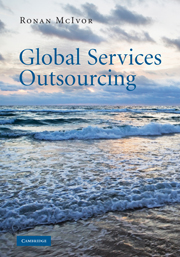Book contents
- Frontmatter
- Contents
- List of figures
- List of tables
- List of illustrations
- Acknowledgements
- 1 Introduction
- 2 Global services outsourcing overview
- 3 Making the services outsourcing decision
- 4 Location and sourcing model choice in global services outsourcing
- 5 Managing global services outsourcing arrangements
- 6 Creating shared services arrangements
- 7 Services outsourcing and performance management
- 8 Services outsourcing and the spin-off arrangement
- 9 Learning from failure and strategies for recovery in business process outsourcing
- 10 Conclusion
- Glossary
- Index
- References
8 - Services outsourcing and the spin-off arrangement
Published online by Cambridge University Press: 05 June 2012
- Frontmatter
- Contents
- List of figures
- List of tables
- List of illustrations
- Acknowledgements
- 1 Introduction
- 2 Global services outsourcing overview
- 3 Making the services outsourcing decision
- 4 Location and sourcing model choice in global services outsourcing
- 5 Managing global services outsourcing arrangements
- 6 Creating shared services arrangements
- 7 Services outsourcing and performance management
- 8 Services outsourcing and the spin-off arrangement
- 9 Learning from failure and strategies for recovery in business process outsourcing
- 10 Conclusion
- Glossary
- Index
- References
Summary
Introduction
Spinning off non-core functions into separate businesses has become increasingly prevalent as organisations restructure and specialise in core areas. The spin-off arrangement is often used as an alternative to outsourcing functions to an independent vendor. Organisations have spun off parts of their operations into separate profitable businesses in an attempt to concentrate further on their core business, or as an alternative to outsourcing the function to an independent vendor. The spin-off arrangement can be an attractive alternative to straightforward outsourcing as the staff transferred will have an intimate knowledge of requirements, and the parent will still have significant influence over the spin-off business. Some have argued that spin-offs are important in unleashing entrepreneurial potential, both by creating dynamic new enterprises and by creating leaner, competitive and more focused parent companies. An often-cited example of a spin-off is the case of Mercedes-Daimler AG spinning off its information technology (IT) function into a separate company, DaimlerChrysler Services. Mercedes-Daimler AG regarded the expertise in this department as world-class with significant potential to generate additional revenue. This spin-off competed in the IT market against established companies, while still delivering IT services to its parent.
There are a number of reasons why companies spin off businesses. The efficient management of certain parts of the business often requires skills and capabilities that are not present in the parent company. Consider a manufacturing firm that is operating in an industry that requires specialist skills in research and development.
- Type
- Chapter
- Information
- Global Services Outsourcing , pp. 214 - 238Publisher: Cambridge University PressPrint publication year: 2010



